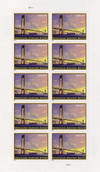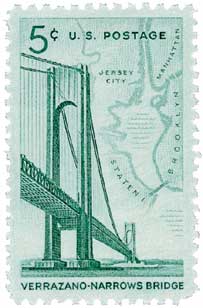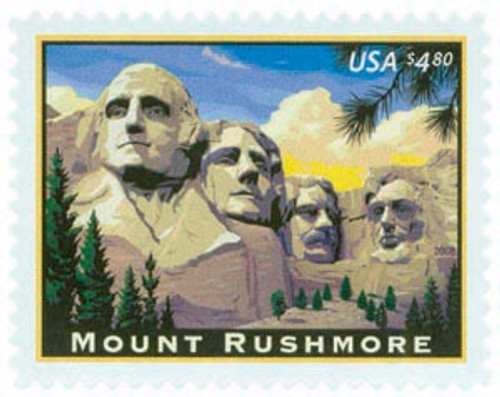
# 4872 - 2014 $5.60 Verrazano-Narrows Bridge, Priority Mail
American Landmarks
City: Brooklyn, NY
Quantity: 10,000,000
Printed By: Ashton Potter USA Ltd.
Printing Method: Lithographed in sheets of 120 with 12 panes of 10 per sheet
Perforations: Serpentine Die Cut 10 ¾ X 10 ½
Self-adhesive
Verrazano-Narrows Bridge Opens
Since 1888, New Yorkers looked for an easier way to cross the Narrows, the tidal strait between the boroughs of Staten Island and Brooklyn. These earliest discussions called for a tunnel, but were scrapped when talk of a bridge arose. The bridge idea was then dropped and they returned to the idea of a tunnel. In fact, they began digging tunnels but ultimately abandoned those too. However, some of those tunnels still remain today.
For decades, the debate continued on whether to build a bridge or finish the tunnels. Then, finally, in 1946 real progress was made by New York Parks Commissioner and Triborough Bridge and Tunnel Authority head Robert Moses. He planned the bridge to complete an expressway system he’d built over several years.
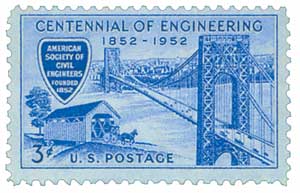
Moses hired Othmar Ammann as the Chief Engineer. Ammann had designed many other famous New York bridges including the George Washington, Bayonne, Bronx Whitestone, Triborough, and Throgs Neck Bridges.
After plans for the bridge were made public, suggestions were submitted for a name. In 1951 the Italian Historical Society of America proposed the bridge be named for Italian explorer Giovanni da Verrazzano, the first European to see New York harbor. As Verrazzano was largely unknown to the public, the society worked tirelessly to get his name out there. They managed to get April 17 (the date he arrived in New York harbor) named Verrazzano Day. But the bridge and tunnel authority refused because his name was too long and they’d never heard of him.
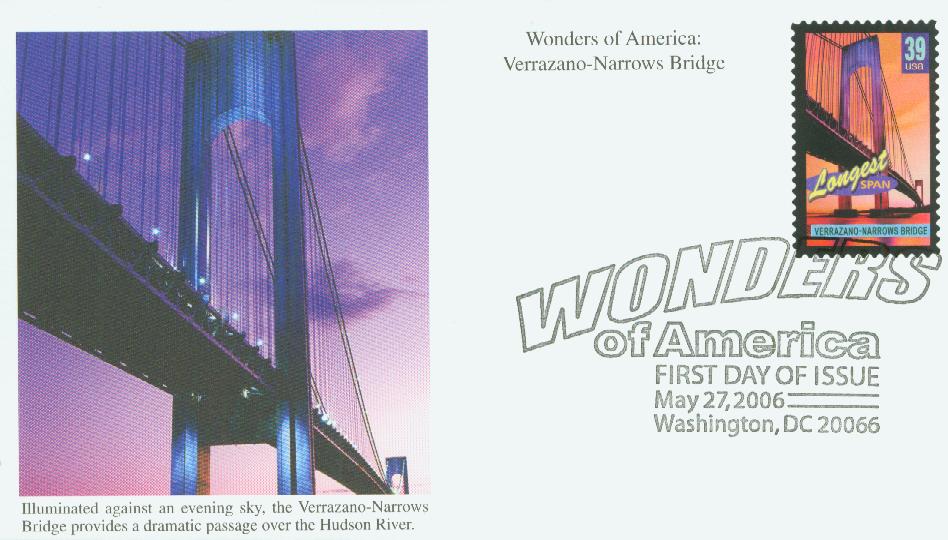
The society continued to push for the name and eventually got a bill to the New York State Assembly. In 1960 the bill passed and was signed into law by Governor Nelson Rockefeller. A few years later, after president Kennedy was assassinated, there were calls to have the under-construction bridge named in his honor, but they failed. And even after the bridge was completed, many people refused to use the name Verrazano, instead calling it the Narrows Bridge, or the Brooklyn-Staten Island Bridge. The society lobbied for many years to ensure the name remained. In spite of all their efforts however, its interesting to note that the name of the Verrazano Bridge is misspelled, as its namesake had two z’s in his name.
Construction on the bridge officially began on August 13, 1959, and progressed quickly. The bridge entrances were built upon the sites of Fort Hamilton and Fort Wadsworth, two historic seacoast fortresses erected after the Revolutionary War to guard the strategic Narrows of New York Harbor. However, it was also at the center of a large controversy because it was planned to be built in the Bay Ridge neighborhood. Ultimately, about 7,000 people were forced to move so construction could continue.
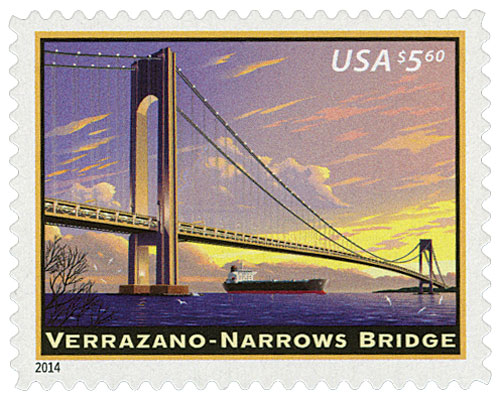
Over the course of five years, about 12,000 men worked on the bridge. After three men fell to their deaths, workers went on strike demanding safety nets. These nets were brought in within four days and the men returned to work. The nets eventually saved the lives of three men who fell during their work.
The bridge’s upper level was completed in 1964 and an official opening ceremony planned. That ceremony was held on November 21, 1964. According to a New York Times article, “The sun shone, the sky was cloudless; bands played, cannons echoed up and down the harbor, flags waved, and thousands of motorists yesterday became part of the first – and perhaps only – blissful traffic jam on the Verrazano-Narrows Bridge.” Just before opening, local politicians cut a ribbon with golden scissors in front a grandstand filled with 1,500 people. The toll to cross the bridge on that first day was 50¢ each way (today a $16 toll is collected for people traveling westbound into Staten Island).
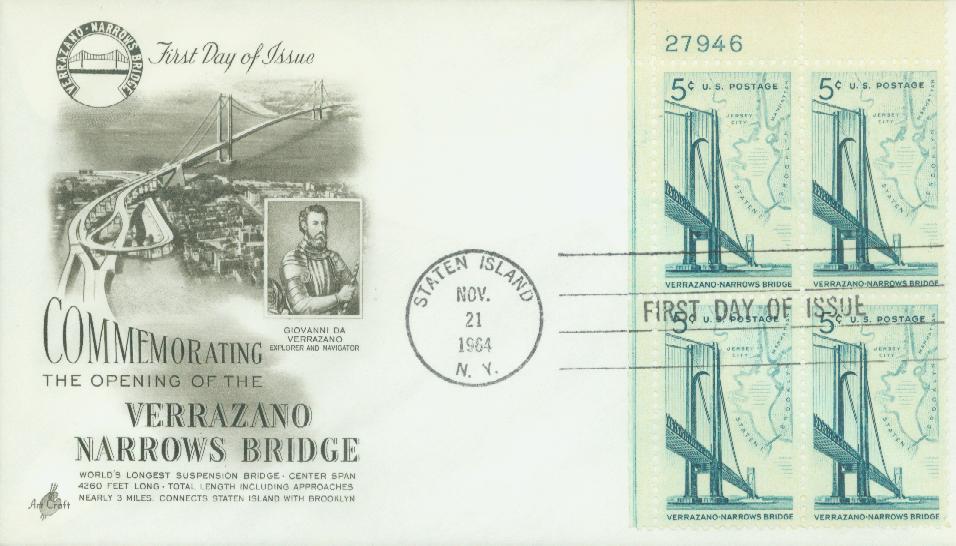
When it was completed, the Verrazano-Narrows Bridge was the longest suspension bridge in the world. It lost that title in 1981 to the Humber Bridge in England, but remains the longest bridge in the U.S. In fact, it’s 60 feet longer than the Golden Gate Bridge in San Francisco! The year following its opening, the number of cars using the bridge was estimated at 48,000 each day. A lower deck, originally scheduled to open in 1975, was opened in 1969 due to traffic demands. The bridge also led to a massive increase in homes and businesses on Staten Island, doubling its population from 221,000 in 1960 to 443,000 in 2000.
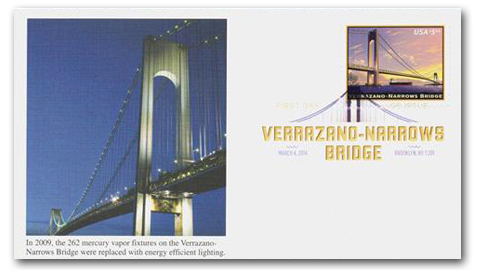
The bridge is 13,700 feet long and contains enough concrete to build a single-lane highway from New York to Washington, D.C. Two 693-foot towers that weigh 27,000 tons apiece support the bridge. Three million rivets and one million bolts hold each tower together. More than 143,000 miles of cables support the bridge. Laid end to end, the wire would reach halfway to the moon. Seasonal expansion and contractions of the steel cables cause the double-decked bridge to be 12 feet lower during summer months.
The Verrazano has been the starting point of the New York City Marathon since 1976, and as the gateway to New York Harbor; all ships must pass under it.
American Landmarks
City: Brooklyn, NY
Quantity: 10,000,000
Printed By: Ashton Potter USA Ltd.
Printing Method: Lithographed in sheets of 120 with 12 panes of 10 per sheet
Perforations: Serpentine Die Cut 10 ¾ X 10 ½
Self-adhesive
Verrazano-Narrows Bridge Opens
Since 1888, New Yorkers looked for an easier way to cross the Narrows, the tidal strait between the boroughs of Staten Island and Brooklyn. These earliest discussions called for a tunnel, but were scrapped when talk of a bridge arose. The bridge idea was then dropped and they returned to the idea of a tunnel. In fact, they began digging tunnels but ultimately abandoned those too. However, some of those tunnels still remain today.
For decades, the debate continued on whether to build a bridge or finish the tunnels. Then, finally, in 1946 real progress was made by New York Parks Commissioner and Triborough Bridge and Tunnel Authority head Robert Moses. He planned the bridge to complete an expressway system he’d built over several years.

Moses hired Othmar Ammann as the Chief Engineer. Ammann had designed many other famous New York bridges including the George Washington, Bayonne, Bronx Whitestone, Triborough, and Throgs Neck Bridges.
After plans for the bridge were made public, suggestions were submitted for a name. In 1951 the Italian Historical Society of America proposed the bridge be named for Italian explorer Giovanni da Verrazzano, the first European to see New York harbor. As Verrazzano was largely unknown to the public, the society worked tirelessly to get his name out there. They managed to get April 17 (the date he arrived in New York harbor) named Verrazzano Day. But the bridge and tunnel authority refused because his name was too long and they’d never heard of him.

The society continued to push for the name and eventually got a bill to the New York State Assembly. In 1960 the bill passed and was signed into law by Governor Nelson Rockefeller. A few years later, after president Kennedy was assassinated, there were calls to have the under-construction bridge named in his honor, but they failed. And even after the bridge was completed, many people refused to use the name Verrazano, instead calling it the Narrows Bridge, or the Brooklyn-Staten Island Bridge. The society lobbied for many years to ensure the name remained. In spite of all their efforts however, its interesting to note that the name of the Verrazano Bridge is misspelled, as its namesake had two z’s in his name.
Construction on the bridge officially began on August 13, 1959, and progressed quickly. The bridge entrances were built upon the sites of Fort Hamilton and Fort Wadsworth, two historic seacoast fortresses erected after the Revolutionary War to guard the strategic Narrows of New York Harbor. However, it was also at the center of a large controversy because it was planned to be built in the Bay Ridge neighborhood. Ultimately, about 7,000 people were forced to move so construction could continue.

Over the course of five years, about 12,000 men worked on the bridge. After three men fell to their deaths, workers went on strike demanding safety nets. These nets were brought in within four days and the men returned to work. The nets eventually saved the lives of three men who fell during their work.
The bridge’s upper level was completed in 1964 and an official opening ceremony planned. That ceremony was held on November 21, 1964. According to a New York Times article, “The sun shone, the sky was cloudless; bands played, cannons echoed up and down the harbor, flags waved, and thousands of motorists yesterday became part of the first – and perhaps only – blissful traffic jam on the Verrazano-Narrows Bridge.” Just before opening, local politicians cut a ribbon with golden scissors in front a grandstand filled with 1,500 people. The toll to cross the bridge on that first day was 50¢ each way (today a $16 toll is collected for people traveling westbound into Staten Island).

When it was completed, the Verrazano-Narrows Bridge was the longest suspension bridge in the world. It lost that title in 1981 to the Humber Bridge in England, but remains the longest bridge in the U.S. In fact, it’s 60 feet longer than the Golden Gate Bridge in San Francisco! The year following its opening, the number of cars using the bridge was estimated at 48,000 each day. A lower deck, originally scheduled to open in 1975, was opened in 1969 due to traffic demands. The bridge also led to a massive increase in homes and businesses on Staten Island, doubling its population from 221,000 in 1960 to 443,000 in 2000.

The bridge is 13,700 feet long and contains enough concrete to build a single-lane highway from New York to Washington, D.C. Two 693-foot towers that weigh 27,000 tons apiece support the bridge. Three million rivets and one million bolts hold each tower together. More than 143,000 miles of cables support the bridge. Laid end to end, the wire would reach halfway to the moon. Seasonal expansion and contractions of the steel cables cause the double-decked bridge to be 12 feet lower during summer months.
The Verrazano has been the starting point of the New York City Marathon since 1976, and as the gateway to New York Harbor; all ships must pass under it.







